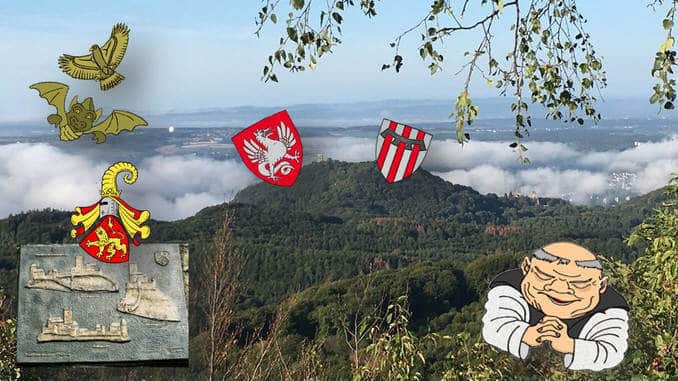
Drachenfels = Dragon’s Rock, Löwenburg = Lions Castle – these names sound like places from a fairy tale. About the heraldic animals dragons and lions.
On the coat of arms of the burgraves of Drachenfels we see a silver dragon on a red background looking to the right. The Counts of Sayn, lords of Löwenburg, actually had a lion in their coat of arms. Where does that come from? About dragons and lions as heraldic animals.
Dragons in the Middle Ages
Dragons and dragon legends were very popular in the Middle Ages. There is a nice booklet (in German) about the famous monk Caesarius of Heisterbach and his dragon friend Schandor. They have been meeting for many years on full moon nights in the ruins of Heisterbach Abbey, telling each other stories, beautiful stories. As a dragon, Schandor lives very long, whereas Caesarius has become a ghost.
Dragons threaten humans
For a human, it was not unusual to encounter a dragon. A medieval man had probably never seen a dragon himself, but he did not rule out the possibility that they existed somewhere else in the world. What is unusual is that Caesarius and Schandor treated each other friendly because the dragon stood for every conceivable evil that might harm humans, even as the incarnation of the devil. The real Caesarius did know about this. In his time, the dragon had a bad hand of cards in the “real world”.
St. George, the dragon fighter
Pious people praised Saint George, the dragon fighter. In Cologne, the Romanesque church of St. Georg had been standing for around 150 years, and the Benedictine monks in nearby Abbey in Siegburg were also very revered. At the time of the Crusades, the legend of St. George the dragon fighter became very popular. It said he had who once killed a dragon in distant Libya, saved the king’s daughter from being sacrificed to the dragon, and liberated an entire city. As a result, everyone there had been baptized.
The main message war: the Christian knight had defeated the evil par excellence. Now Saint. George became a warrior saint and patron saint of the crusaders, and they carried his name to their European homelands. When King Richard the Lionheart was in the Holy Land, he took the Saint George’s Cross, it became England’s flag and George became the patron of England.
Heraldic animal dragon
But one was also aware of the dragons’ power, strength and “threat-potential”, they stood for alertness, wisdom, and strength. That’s why dragons can be found on army flags, coats of arms and shields. We know about draco standard in the Imperial Roman cavalry, in our region a draco standard from the Roman fort Niederbieber has remained.
In Medieval Europe, dragons have a prominent place only in England. No other than King Arthur wore a red dragon on his tunic. His royal father Uther Pendragon carried dragons in his name. In Germany, we find the dragons with Emperor Otto IV, he had the imperial eagle and dragons as army flags. In his case, the trace leads to his maternal family, the Anglo-Norman Plantagenets, who saw themselves as being in the succession of Arthur.
Castle Drachenfels
Now what made burgraves on Mount Drachenfels have a dragon for their coat of arms? Unfortunately, we do not know so much about them from the High Middle Ages. The earliest documents that have remained date from the beginning of the 12th century, they mention the mountain Drachenfels (Dragon’s Rock), Trachefelz or, somewhat pathetic in medieval Latin, the “Mons Draconis”. Most likely, the newly appointed burgraves adopted the name of the mountain for their castle and their coat of arms.
Much later, at the time of the House of Luxemburg, we meet burgrave Godart of Drachenfels, yet he did not live in the castle, but in a comfortable and heated house down in Königswinter. He owned large estates on the left side of the Rhine, therefore called “Drachenfelser Ländchen”. The town of Wachtberg still carries a magnificent dragon in its coat of arms.
The site of a dragon fight?
Since we don’t have any historical data from the first millennium, we can only make guesses. Perhaps the name derives from legends. There is the legend of the Christian virgin who was to be sacrificed to a hideous dragon dwelling in a cave on the mountain.
And then, of course, there is the legend of Siegfried, the dragon slayer. In the Nibelungenhalle you can see a replica of Fafnir, the dragon that was slayed by Siegfried, according to legend here on Mount Drachenfels. But the Nibelungenlied itself says little about the dragon fight, and only indirectly. Hagen sees Siegfried as a rival and warns against him because Siegfried is a hero and dragon slayer. The way from Xanten to Worms leads past the Drachenfels, but there is no reference to it in the text.
Another derivation comes from trachyte, i.e., trachyte rock. However, this term was introduced by a French mineralogist in 1813 only.
Lions in the Middle Ages
Unlike the dragons, the lions are highly appreciated heraldic animals.
Löwenburg
Löwenburg, Lion Castle, here we have the medieval German word “lewe”, German Löwe, the lion. And indeed, the Counts of Sayn had a lion in their coat of arms. Löwenburg castle was a border fortress, built during a time of troubles, so they probably named the mountain and their castle after their heraldic animal, as a warning to the territorial neighbors.
Heraldic animal Lion
The lion is a very popular heraldic animal. He symbolizes courage, enormous strength and royalty, after all the lion is considered the king of the animals. It is therefore not surprising that many high and low noblemen have a lion in their coat of arms.
In heraldry, however, not all lions are the same. When the lion walks on his four legs and looks at the observer, heraldry speaks of a leopard. Three golden striding lions on a red background, here we have the coat of arms of Richard the Lionheart, which became the English coat of arms. His nephew Otto IV’s coat of arms was split, half Richard’s, have the imperial eagle.
The House of Hohenstaufen also had its lions, three black lions striding to the right with red tongues on a golden ground. Today, we encounter them in the coat of arms of Baden-Württemberg. Hesse and Thuringia have a colorful lion as their heraldic animal, and the lion appears several times in the Bavarian coat of arms.
The Duchy of Berg’s lion
If the lion stands on his hind paws and has his front paws in the air, heraldry speaks of a lion. We still have a real heraldic lion, the heraldic animal of the former duchy of Berg. It is exactly a Limburg lion that Henry IV of Limburg added to Berg’s coat of arms when he became Duke of Berg in 1225. Walking upright, this proud lion appears on the coat of arms of many cities that once belonged to the duchy, Bergisches Land in German, Berg Country. Last but now least, we find him on one half of the coat of arms of Königswinter, next to the black on white cross representing the Archbishopric of Cologne.
Heraldic animals dragons and lions | Read more
The Heraldry Society, The Origin of the Royal Arms of England, a European Connection

Be the first to comment